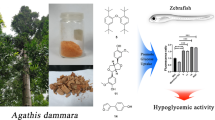Abstract
A 16-member polyether macrocyclic lactone, with previously unreported framework was isolated as a result of the bioassay guided chromatographic fractionation of the ethyl acetate-methanol extract of the Babylonidae Babylonia spirata collected from the southwestern coast of Indian peninsular. The compound was characterized as 10, 14-dihydroxy-4-(1′-propyl-1′(Z)-hexen-1′-yl)-7, 12-dioxapentadecanolide based on extensive spectral data analysis. The antioxidant activities evaluated by in vitro free radical scavenging capacities reported that the studied compound possessed greater activity (IC50 0.058–0.065 × 10−2 M) than the commercial standards, butylated hydroxy anisole, butylated hydroxyl toluene and α-tocopherol (IC50 0.118–0.189 × 10−2 M). The compound was found to possess greater anti-inflammatory potentials as recognized by its lower IC50 value for the 5-lipoxygenase inhibition assay (0.073 × 10−2 M) than the non steroidal anti-inflammatory drugs aspirin (0.211 × 10−2 M) and ibuprofen (0.436 × 10−2 M). Structure-activity studies showed that bioactivities of the polyether macrocyclic lactone were directed by electronic and lipophilic descriptors. The lipophilic parameter of octanol-water partition coefficient (log Pow) of the studied compound recorded a value as low as 2.76 when judged against commercial antioxidant α-tocopherol (log Pow 9.98), and was recognized as a primary physico-chemical descriptor dictating the antioxidant characteristics of the isolated polyether macrocyclic lactone, whereas the electronic parameters appeared to contribute towards its anti-inflammatory activity. This is the first report of the occurrence of macrocyclic lactone featuring a dioxapentadecanolide framework possessing potential antioxidative and anti-inflammatory activities, and therefore, anticipated as a potential naturally-derived antioxidative and anti-inflammatory constituent in functional food and pharmaceutical applications.



Similar content being viewed by others
References
Altena CO, van R, Gittenberger E (1981) The genus Babylonia (Prosobranchia, Buccinidae). Zool Verh 188:3–57
Ambrosioa MD, Tato MÁ, Pocsfalvic G, Debitusd C, Pietraa F (1999) Leucascandrolide B, a new 16-membered, extensively methyl branched polyoxygenated macrolide from the calcareous sponge Leucascandra caveolata from northeastern waters of New Caledonia Helvet Chim Acta 82(3):347–353
Baylac S, Racine P (2003) Inhibition of 5-lipoxygenase by essential oils and other natural fragment extracts. Int J Aromather 13(2-3):138–142
Chellaram C, Edward JKP (2009a) Antinociceptive assets of coral associated Gastropod, Drupa margariticola. Int J Pharm 5:236–239
Chellaram C, Edward JKP (2009b) In vivo anti-inflammatory bustle of reef associated mollusc, Trochus tentorium. Adv Biotech 9:32–34
Chew YL, Lim YY, Omar M, Khoo KS (2008) Antioxidant activity of three edible seaweeds from two areas in South East Asia. LWT. J Food Sci Technol 41(6):1067–1072
Frank AT, Farina NS, Sawwan N, Wauchope OR, Qi ME, Brzostowska M, Chan W, Grasso FW, Haberfield P, Greer A (2007) Natural macrocyclic molecules have a possible limited structural diversity. Mol Divers 11:115–118
Fraussen K, Stratmann D (2013) The family Babyloniidae. In: Poppe GT, Groh K (eds) A conchological iconography. Conchbooks, Harxheim, p 96
Govindarajalu J, Anand M, Chelladurai G, Kumaraguru A (2016) Bioactive potential of some economically important marine gastropods along the Gulf of Mannar region, southeast coast of India. JCLM 4(8):608–611
Huryn DM, Wipf P (2014) Natural product chemistry and cancer drug discovery. In: Neidle S (ed) Cancer drug design and discovery.. Academic Press, San Diego, p 91–120
Joy M, Chakraborty K (2016) First report of two new antioxidative meroterpeno 2H-pyranoids from short-necked yellow-foot clam Paphia malabarica (family: Veneridae) with bioactivity against pro-inflammatory cyclooxygenases and lipoxygenase. Nat Prod Res 31(6):615–625
Joy M, Chakraborty K (2017) Previously undescribed antioxidative and anti-inflammatory chromenyls bearing 3H-isochromenone and furanyl-2H-chromenyl skeletons from the venerid clam, Paphia malabarica. Med Chem Res 26(8):1708–1722
Kujawski J, Popielarska H, Myka A, Drabińska B, Bernard MK (2012) The log P parameter as a molecular descriptor in the computer-aided drug design—an overview. CMST 18(2):81–88
Kuppusamy A, Ulagesan S (2016) Antimicrobial activity of protein hydrolysate from marine molluscs Babylonia spirata (Linnaeus, 1758). J Appl Pharm Sci 6(7):73–77
Lipinski C, Hopkins A (2004) Navigating chemical space for biology and medicine. Nature 432(7019):855–861
Makkar F, Chakraborty K (2018) Novel furanyl derivatives from the red seaweed Gracilaria opuntia with pharmacological activities using different in vitro models. Med Chem Res 27(4):1245–1259
Montaser R, Luesch H (2011) Marine natural products: a new wave of drugs? Future Med Chem 3(12):1475–1489
Oguchi K, Tsuda M, Iwamoto R, Okamoto Y, Endo T, Kobayashi J, Ozawa T, Masuda A (2007) Amphidinolides B6 and B7, cytotoxic macrolides from a symbiotic dinoflagellate Amphidinium species. J Nat Prod 70(10):1676–1679
Quan LD, Thiele GM, Tian J, Wang D (2008) The development of novel therapies for rheumatoid arthritis. Expert Opin Ther Pat 18(7):723–738
Santhi V, Sivakumar V, Thilaka RD, Thangathirupathi A (2012) Analgesic, antipyretic and anti inflammatory activities of column fraction of Babylonia zeylanica (Bruguiere, 1789) in albino rats. Int J Pharm Bio Sci 2(3):151–159
Schnitzer J, Kamin M, Olson WH (1999) Tramadol allows reduction of naproxen dose among patients with naproxen-responsive osteoarthritis pain. Arthritis Rheumatol 42(7):1370–1377
Wojdylo A, Oszmianski J, Czemerys R (2007) Antioxidant activity and phenolic compounds in 32 selected herbs. Food Chem 105:940–949
Walters WP, Murcko MA (1998) Can we learn to distinguish between “drug-like” and “nondrug-like” molecules? J Med Chem 41(18):3314–3324
Acknowledgements
The authors are thankful to Indian Council of Agricultural Research-Central Institute of Post-Harvest Engineering and Technology (ICAR-CIPHET) for funding under the ICAR-Consortium Research Platform project on “Health Food” (grant number ICAR/HF/2012-2017). The authors thank the Director, ICAR-Central Marine Fisheries Research Institute (ICAR-CMFRI) for his guidance and support. Thanks are due to the Head, Marine Biotechnology Division of ICAR-CMFRI for facilitating the research activities.
Author information
Authors and Affiliations
Corresponding author
Ethics declarations
Conflict of interest
The authors declare that they have no conflict of interest.
Additional information
These authors contributed equally: Soumya Salas, Kajal Chakraborty.
Electronic supplementary material
Rights and permissions
About this article
Cite this article
Salas, S., Chakraborty, K. An unreported polyether macrocyclic lactone with antioxidative and anti-lipoxygenase activities from the Babylonidae gastropod mollusc Babylonia spirata. Med Chem Res 27, 2446–2453 (2018). https://doi.org/10.1007/s00044-018-2248-z
Received:
Accepted:
Published:
Issue Date:
DOI: https://doi.org/10.1007/s00044-018-2248-z




